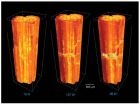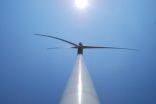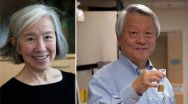(Press-News.org) Advanced ceramic composites can withstand the ultrahigh operational temperatures projected for hypersonic jet and next generation gas turbine engines, but real-time analysis of the mechanical properties of these space-age materials at ultrahigh temperatures has been a challenge – until now. Researchers with the U.S. Department of Energy (DOE)'s Lawrence Berkeley National Laboratory (Berkeley Lab) have developed the first testing facility that enables CT-scanning of ceramic composites under controlled loads at ultrahigh temperatures and in real-time.
Working at Berkeley Lab's Advanced Light Source (ALS), a premier source of X-ray and ultraviolet light beams, the scientists created a mechanical testing rig for performing X-ray computed microtomography that reveals the growth of microcrack damage under loads at temperatures up to 1,750 degrees Celsius. This allows engineers to compute a ceramic composite material's risk of structural or mechanical failure under extreme operating conditions, which in turn should enable the material's performance and safety to be improved.
"The combination of our in situ ultrahigh temperature tensile test rig and the X-rays at ALS Beamline 8.3.2 allows us to obtain measurements of the mechanical properties of advanced ceramic materials at temperatures that are literally unprecedented," says Berkeley Lab materials scientist Robert Ritchie, who led this work. "These measurements, coupled with wonderful 3D images and quantitative data of the damage under load, can provide crucial information to permit accurate predictions of a ceramic composite's structural integrity and safe lifetime."
Ritchie, who holds joint appointments with Berkeley Lab's Materials Sciences Division and the University of California (UC) Berkeley's Materials Science and Engineering Department, is the corresponding author of a paper describing this work that has been published in the journal Nature Materials. The paper is titled "Real-time quantitative imaging of failure events in materials under load at temperatures above 1,600○C." Co-authors of the paper were Hrishikesh Bale, Abdel Haboub, Alastair MacDowell, James Nasiatka, Dilworth Parkinson, Brian Cox and David Marshall.
Ceramics made from clay have been used as construction materials for thousands of years and are renowned for their ability to resist damage from water, chemicals, oxidation and – most importantly - heat. Ceramics can stand up to temperatures that would melt most metals. However, traditional ceramics also suffer from a serious deficit – brittleness. Today's advanced ceramics for extreme structural applications are much stronger and tougher. They're reinforced with ceramic fibers to form composites that can be structured along the lines of natural materials such as bone and shells. Jet or turbine gas engines made from ceramic composites would weigh considerably less than today's engines and operate at much higher temperatures. This translates into far greater fuel efficiencies and reduced pollution.
Still, while ceramic composites are far less prone to fracture than their clay ancestors, tiny cracks can form and grow within their complex microstructures, creating potentially catastrophic problems.
"Like bone and shells, ceramic composites achieve robustness through complexity, with their hierarchical, hybrid microstructures impeding the growth of local damage and preventing the large fatal cracks that are characteristic of brittle materials," Ritchie says. "However, complexity in composition brings complexity in safe use. For ceramic composites in ultrahigh temperature applications, especially where corrosive species in the environment must be kept out of the material, relatively small cracks, on the order of a single micron, can be unacceptable."
Exactly how micro-cracks are restrained by the tailored microstructures of a ceramic composite is the central question for the materials scientist seeking the optimal composition or architecture, and the design engineer who must predict the failure envelope, Ritchie says. The only reliable way to answer this question is through measurements made at ultrahigh temperatures.
ALS Beamline 8.3.2, which is powered by a 6 Tesla superconducting bend magnet, is designed for X-ray computed microtomography, a technology that provides non-destructive 3D imaging of solid objects at a resolution of approximately one micron. With the addition of their unique tensile testing rig, Ritchie and his colleagues can maintain in situ ultrahigh temperature environments in either inert or oxidizing atmospheres while obtaining real-time 3D images of sample microstructures. In their Nature Materials paper, Ritchie and his coauthors describe obtaining 3D images of the microstructures of ceramic composite samples made from silicon-carbide at sufficient resolution to observe the formation of microcracks and other forms of internal damage as a function of load.
"The results of our tests provided vital information pertaining to the underlying failure mechanisms within ceramic composites that can be used to optimize their performance, Ritchie says.
"The capacity for validating virtual testing models through direct, real-time, non-invasive experimental observations should greatly advance our understanding and help promote the technological innovation of ceramic composites."
INFORMATION:
This work was done in collaboration with the Teledyne Scientific Company through a grant from NASA and the U.S. Air Force.
Lawrence Berkeley National Laboratory addresses the world's most urgent scientific challenges by advancing sustainable energy, protecting human health, creating new materials, and revealing the origin and fate of the universe. Founded in 1931, Berkeley Lab's scientific expertise has been recognized with 13 Nobel prizes. The University of California manages Berkeley Lab for the U.S. Department of Energy's Office of Science. For more, visit www.lbl.gov.
DOE's Office of Science is the single largest supporter of basic research in the physical sciences in the United States, and is working to address some of the most pressing challenges of our time. For more information, please visit the Office of Science website at science.energy.gov/.
Space-age ceramics get their toughest test
Berkeley lab researchers develop real-time CT-scan test rig for ceramic composites at ultrahigh temperatures
2012-12-10
ELSE PRESS RELEASES FROM THIS DATE:
Study identifies potential new pathway for drug development
2012-12-10
A newly found understanding of receptor signaling may have revealed a better way to design drugs. A study from Nationwide Children's Hospital suggests that a newly identified group of proteins, alpha arrestins, may play a role in cell signaling that is crucial to new drug development. The study appears in PLOS ONE.
More than one-third of drugs on the market work by targeting G protein-coupled receptors that control how cells communicate and function. With many hundreds of members, G protein-coupled receptors are the largest family of signaling receptors throughout the ...
Infants with severe RSV disease may be immunosuppressed
2012-12-10
Infants with severe lower respiratory tract infection caused by respiratory syncytial virus (RSV) may have a dysfunctional innate immune response that relates to the severity of their disease. These are the findings from a Nationwide Children's Hospital study appearing in a recent issue of the Journal of Infectious Diseases.
RSV is the leading cause of lower respiratory tract infection in young children worldwide. The majority of children hospitalized with this condition are previously healthy with no known risk factors for serious disease. Of these infants, up to 20 ...
Caffeinated coffee may reduce the risk of oral cancers
2012-12-10
ATLANTA – December 10, 2012—A new American Cancer Society study finds a strong inverse association between caffeinated coffee intake and oral/pharyngeal cancer mortality. The authors say people who drank more than four cups of caffeinated coffee per day were at about half the risk of death of these often fatal cancers compared to those who only occasionally or who never drank coffee. The study is published online in the American Journal of Epidemiology. The authors say more research is needed to elucidate the biologic mechanisms that could be at work.
Previous epidemiologic ...
Overweight pregnant women not getting proper weight-gain advice
2012-12-10
HERSHEY, Pa. -- Overweight women are not receiving proper advice on healthy weight gains or appropriate exercise levels during their pregnancies, according to Penn State College of Medicine researchers.
"Excessive weight gain during pregnancy is associated with weight retention after delivery and is a positive predictor of obesity after pregnancy," Dr. Cynthia Chuang, associate professor of medicine and public health sciences said. "Excessive gestational weight is particularly concerning for overweight and obese women given their already increased risk for pregnancy ...
Mining ancient ores for clues to early life
2012-12-10
An analysis of sulfide ore deposits from one of the world's richest base-metal mines confirms that oxygen levels were extremely low on Earth 2.7 billion years ago, but also shows that microbes were actively feeding on sulfate in the ocean and influencing seawater chemistry during that geological time period.
The research, reported by a team of Canadian and U.S. scientists in Nature Geoscience, provides new insight into how ancient metal-ore deposits can be used to better understand the chemistry of the ancient oceans – and the early evolution of life.
Sulfate is the ...
Prostate cancer now detectable by imaging-guided biopsy
2012-12-10
Ground-breaking research by a UCLA team of physicians and engineers demonstrates that prostate cancer can be diagnosed using image-guided targeted biopsy.
Traditionally found only by blind biopsy, a procedure that dates from the 1980s, prostate cancer now appears detectable by direct sampling of tumor spots found using Magnetic Resonance Imaging (MRI) in combination with real-time ultrasound, according to the UCLA study released Dec. 10, 2012 early online for the January 2013 issue of The Journal of Urology®.
The study indicates that the MRI and ultrasound fusion biopsy, ...
Targeted prostate biopsy has potential to improve diagnosis of prostate cancer
2012-12-10
New York, NY, December 10, 2012 – Diagnosis of prostate cancer remains imperfect. Current methods of prostate biopsy are limited by over detection of slow-growing tumors and under detection of clinically relevant cancers. Investigators at the University of California-Los Angeles Department of Urology have found that a new technique of targeted biopsy in a clinic setting, using local anesthesia, may improve diagnosis and aid in selecting which patients are suitable for active surveillance and which need focal therapy (noninvasive techniques for destroying small tumors within ...
Renewables and storage could power grid 99.9 percent of the time
2012-12-10
Renewable energy could fully power a large electric grid 99.9 percent of the time by 2030 at costs comparable to today's electricity expenses, according to new research by the University of Delaware and Delaware Technical Community College.
A well-designed combination of wind power, solar power and storage in batteries and fuel cells would nearly always exceed electricity demands while keeping costs low, the scientists found.
"These results break the conventional wisdom that renewable energy is too unreliable and expensive," said co-author Willett Kempton, professor ...
Secrets of gentle touch revealed
2012-12-10
Stroke the soft body of a newborn fruit fly larva ever-so-gently with a freshly plucked eyelash, and it will respond to the tickle by altering its movement—an observation that has helped scientists at the University of California, San Francisco (UCSF) uncover the molecular basis of gentle touch, one of the most fundamental but least well understood of our senses.
Our ability to sense gentle touch is known to develop early and to remain ever-present in our lives, from the first loving caresses our mothers lavish on us as newborns to the fading tingle we feel as our lives ...
Temple scientists target DNA repair to eradicate leukemia stem cells
2012-12-10
(Philadelphia, PA) – Despite treatment with imatinib, a successful drug that targets chronic myeloid leukemia (CML), a deadly type of cancer, some patients may continue to be at risk for relapse because a tiny pool of stem cells is resistant to treatment and may even accumulate additional genetic aberrations, eventually leading to disease progression and relapse. These leukemia stem cells are full of genetic errors, loaded with potentially lethal breaks in DNA, and are in a state of constant self-repair.
Now, scientists at Temple University School of Medicine may have ...
LAST 30 PRESS RELEASES:
Smallholder farms maintain strong pollinator diversity – even when far from forests
Price of a bot army revealed across hundreds of online platforms worldwide – from TikTok to Amazon
Warblers borrow color-related genes from evolutionary neighbors, study finds
Heat signaling from plants is an ancient pollinator signal
New index reveals the economics underlying the online manipulation economy
High-resolution satellite observations reveal facility-level methane emissions worldwide
Researchers discover how Ebola and Marburg disrupt the gastrointestinal tract
Feeling the heat
Eastward earthquake rupture progression along the Main Marmara Fault towards Istanbul
Scientists uncover how Earth’s mantle locked away vast water in early magma ocean
Scientists uncover key driver of treatment-resistant cancer
Rare image of Tatooine-like planet is closest to its twin stars yet
Music: Popular song lyrics have become more negative since 1973
Marine ecology: Killer whales tail dolphins to hunt salmon
ADHD prescriptions on the rise, study finds
How to build a genome
Sharp rise in ADHD stimulant prescriptions in Ontario, research finds
Trends and prevalence of the metabolic syndrome among US adults
Population-level trends in ADHD medication prescribing
Missing piece of myelin disturbs the brain’s rhythm
Insilico Medicine and Taigen achieves license agreement to develop and commercialize AI-driven PHD inhibitor for anemia of Chronic Kidney Disease (CKD)
Exploring dominant endophytic Pleosporales in grasses: New taxonomic insights in the suborder Massarineae
Comparative transcriptomic analysis of human maxillary and mandibular tooth germs reveals discrepancies in gene expression patterns
Scientists detect atmosphere on molten rocky exoplanet - study
Chip-scale magnetometer uses light for high-precision magnetic sensing
Illinois Tech biomedical engineering professor Philip R. Troyk elected as Fellow of the National Academy of Inventors
The National Academy of Inventors welcomes 2025 Class of Fellows
Multi-scale modelling framework predicts mechanical responses of Fe–Cr–Al alloys across composition and processing conditions
Preoperative radiation may improve antitumor immune response in most common form of breast cancer
Breast MRI may be safely omitted from diagnostic workup in certain patients with early-stage, HR-negative breast cancer
[Press-News.org] Space-age ceramics get their toughest testBerkeley lab researchers develop real-time CT-scan test rig for ceramic composites at ultrahigh temperatures



